After the previous European Championships in 2016, many people probably would have predicted Germany to be one of the main favourites for both the 2018 World Cup and this year’s European Championships. Germany though as a national side have had probably one of the most interesting few years since that tournament, with the beginning of this slide coming with their early exit from the 2018 World Cup. Following on from that failure, Germany’s national side looked set for a revamp, and after further failure in the UEFA Nations League, head coach Joachim Löw announced that Mats Hummels, Jerome Boateng, and Thomas Müller would no longer be considered for selection. The rather ominous quote from 2019 which looms over this decision now is “This is the year for our new beginning”.
As I’m sure you know by now, Germany have since reversed that decision and have included both Hummels and Müller in their squad for this tournament. From a purely footballing perspective, this would seem the right decision, as both players still play a pivotal role for their clubs despite their age, and both will likely start for Germany in the tournament.
The German national team’s year of new beginning looks more likely to be this year, and to be precise, just after this tournament ends. Following a torrid last two years in which they have been battered 6-0 by Spain, and defeated by North Macedonia, it was announced in March that Joachim Löw would step down from his role as head coach after Euro 2020. Exits on the directorial side of Germany have also come about, with DFB president Fritz Keller being forced to resign following severely distasteful comments about one of his colleagues. Problems seem to just be leaking out of the DFB at the moment, and it wouldn’t be over the top to describe it as a crisis heading into the tournament. The one cause for optimism though is that Joachim Löw will be replaced by ex-Bayern Munich boss Hansi Flick following the tournament, with Flick serving as Löw’s assistant manager from 2006 to 2014. Following his massive success at Bayern, Flick is rightly considered to be one of the best managers in the business, and so Germany realistically could not ask for a better coach to try and lead them into a new era, and if this is paired with changes at the DFB, Germany will be back looking to compete for silverware again quickly.
This tournament then is an odd one for Germany. With their manager departing and the team currently struggling on the international stage, expectations are low for Die Mannschaft. Having said this, players will be fighting to be a part of this new era for German football, and perhaps more pertinently, Germany still have a squad that possesses world class talent. Because of this, you simply cannot write them off in a tournament, and I don’t think many teams will actively want to play the Germans despite their current struggles. As this analysis will show, their squad is tactically flexible, full of talent, and full of experience, all of which can culminate to a successful tournament. In this tactical analysis we will review the squad using data, and analyse how they will likely set up tactically at Euro 2020.
THE SQUAD
Goalkeepers:
Bernd Leno
Manuel Neuer
Kevin Trapp
Defenders:
Matthias Ginter
Robin Gosens
Christian Günter
Mats Hummels
Lukas Klostermann
Robin Koch
Antonio Rüdiger
Niklas Süle
Midfielders:
Emre Can
Leon Goretzka
İlkay Gündoğan
Kai Havertz
Jonas Hofmann
Joshua Kimmich
Toni Kroos
Florian Neuhaus
Forwards:
Serge Gnabry
Thomas Müller
Jamal Musiala
Leroy Sané
Kevin Volland
Timo Werner
Germany have experimented with some different formations during qualifying campaigns, with the usual fluctuation being between a back three formation and the 4-3-3. In their most recent qualifying games, they seem to have settled on a 4-3-3, and so I would expect them to use this primarily in the tournament. Their squad is one that allows them to adapt tactically to the opposition, and so changes in the line-up will naturally occur depending on the game, however this is my general prediction for who we can expect to start.
In goal, captain Manuel Neuer will start in goal, with any competition removed when Marc Andre Ter Stegen was injured at the end of the season and ruled out of the tournament. At centre back, I expect the recalled Mats Hummels to start alongside Chelsea defender Antonio Rüdiger. Niklas Süle could compete with Rüdiger for a place in the team, however Rüdiger has started more frequently for club and country. At right back, I’d expect Matthias Ginter to start, as he is often a regular at full-back for the national team, despite him playing as a centre back for Borussia Mönchengladbach. Joshua Kimmich could also play there to allow room for another midfielder, but I wouldn’t expect to see this regularly. Germany are rather short of experienced options at left-back, with Robin Gosens, Christian Günter and potentially even Lukas Klostermann competing for this role. Gosens has started in recent qualifiers, while Günter offers a reliable option, however his lack of caps and playing time for the national team leads me to believe he won’t start.
The midfield is clearly Germany’s strongest area of the pitch, and they have three world class midfielders who could start together. I’d expect Toni Kroos to start as the six, and he remains one of the best midfielders at the tournament, as he demonstrated with some impressive performances for Real Madrid this season. In front of Kroos, I expect İlkay Gündoğan to start and act as the main goal threat from the midfield, with the midfielder able to rack up 13 goals in 28 Premier League games this season. Bayern Munich midfielder Joshua Kimmich could also start in midfield, and will likely act as a hybrid between Gündoğan and Kroos’ roles. Leon Goretzka will look to try and force his way into midfield, however without any of the three mentioned players moving positions, I can’t find a way in for him at the moment. Germany could drop into a double pivot to form more of a 4-2-3-1, or could drop into a back three with Kroos, leaving Kimmich to then act as a single pivot. Both players have experience doing this at club level, and so Germany should look to utilise this flexibility.
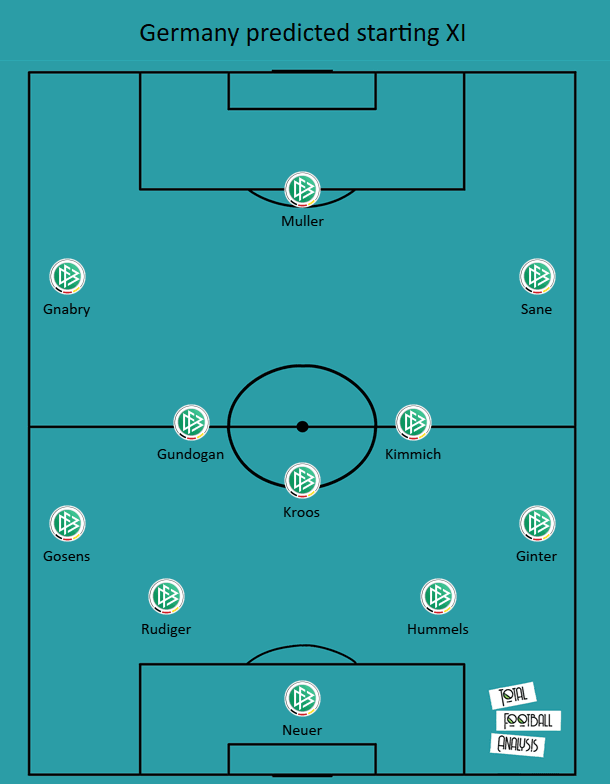
As for forwards, this is where the most variation could occur, as some forwards could drop into midfield, and other players could be preferred depending on the opponent. I would expect the Bayern Munich pair of Leroy Sané and Serge Gnabry to start on either wing, however the likes of Timo Werner and Kai Havertz could start in these positions, with Havertz more likely in games which Germany expect to have to break a deeper opposition block. Sané can play on either wing, as he can cut in and play inside, or provide width to the attack and dribble at defenders. Havertz could also move into midfield if Kimmich is preferred at full-back. Up front, I expect Thomas Müller to start the majority of matches, and his raumdeuter role would allow him to be more fluid. However, Müller could even start wider in that ‘space interpreter’ role while Timo Werner starts up front and provides a threat in behind. If Germany seek to play more in transition in a match, you would expect Werner’s pace to be used up top.
If we evaluate Germany’s squad in terms of age, we see they actually have a number of players in their pool who fall into that prime age category. We can see on the younger side Florian Wirtz and Jamal Musiala, with the latter making the squad despite only having two caps to his name. The former England youth international has impressed for Bayern Munich this season and has picked up a decent number of minutes for his young age.
Germany have a number of key players in their prime, with the likes of Kimmich and Gnabry all in this category and playing a high number of minutes. We see Matthias Ginter and Marc Andre Ter Stegen play the most minutes of anyone in this age category.
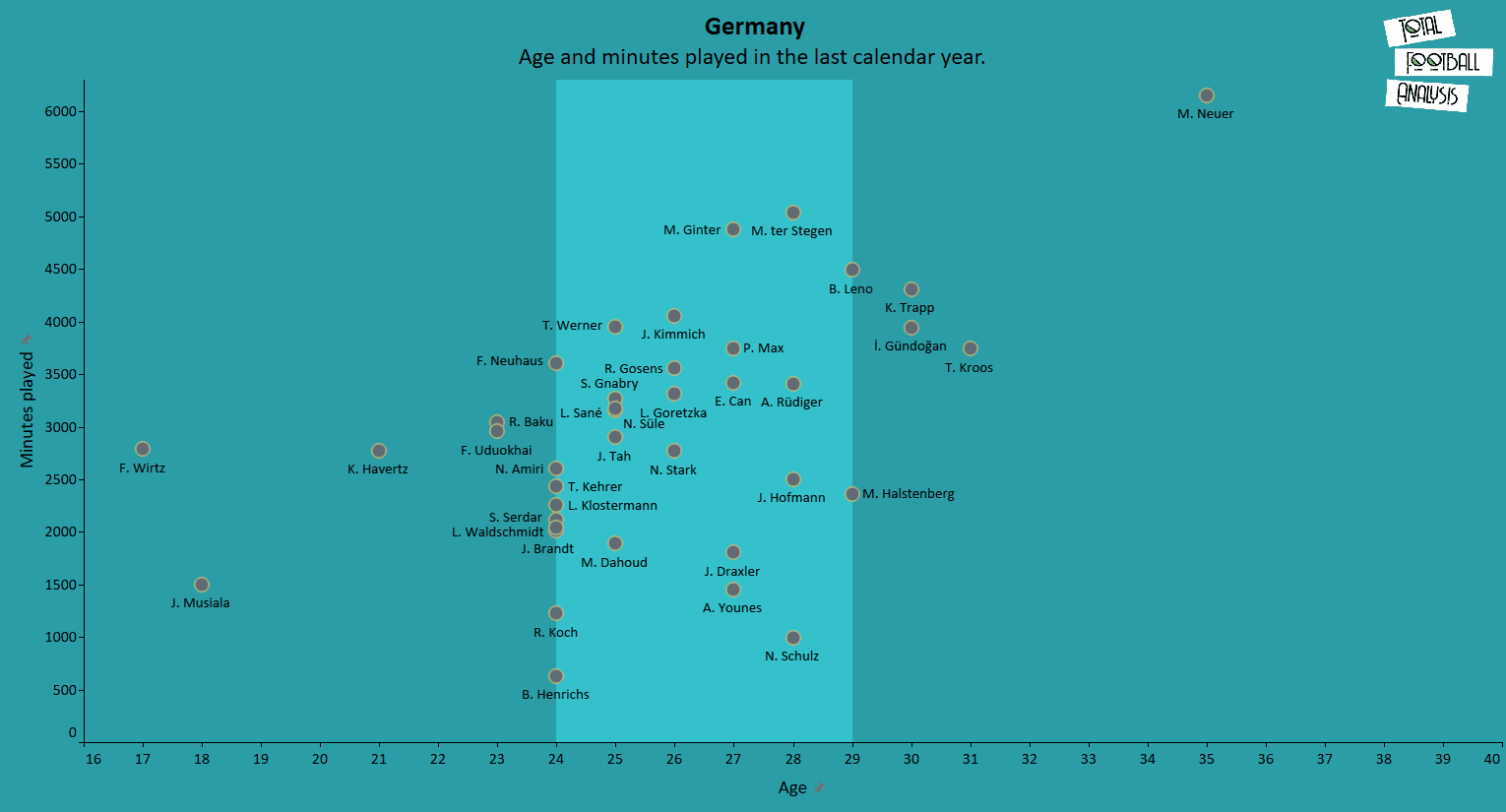
Players such as Kroos and Gündoğan fall outside the prime age category, however Gündoğan has had an excellent season this year. We can see Manuel Neuer in the far top right of the graph standing out as playing a very high number of minutes despite his age, however this likely plays to Germany’s advantage with his experience in big tournaments.
ATTACKING PHASE
Germany are a team that have favoured possessing the ball most often, and have relied upon slower positional attacks often throughout qualifying due to the opposition’s more defensive approach. They have averaged 59% possession in games in the last calendar year, and despite being drawn against some difficult opposition in the group stage, I would expect them to stick to their ideas in terms of shorter, more progressive build-up. Germany have averaged a high number of shots per match and touches in the penalty area, and we can clearly see they have not been a direct side.
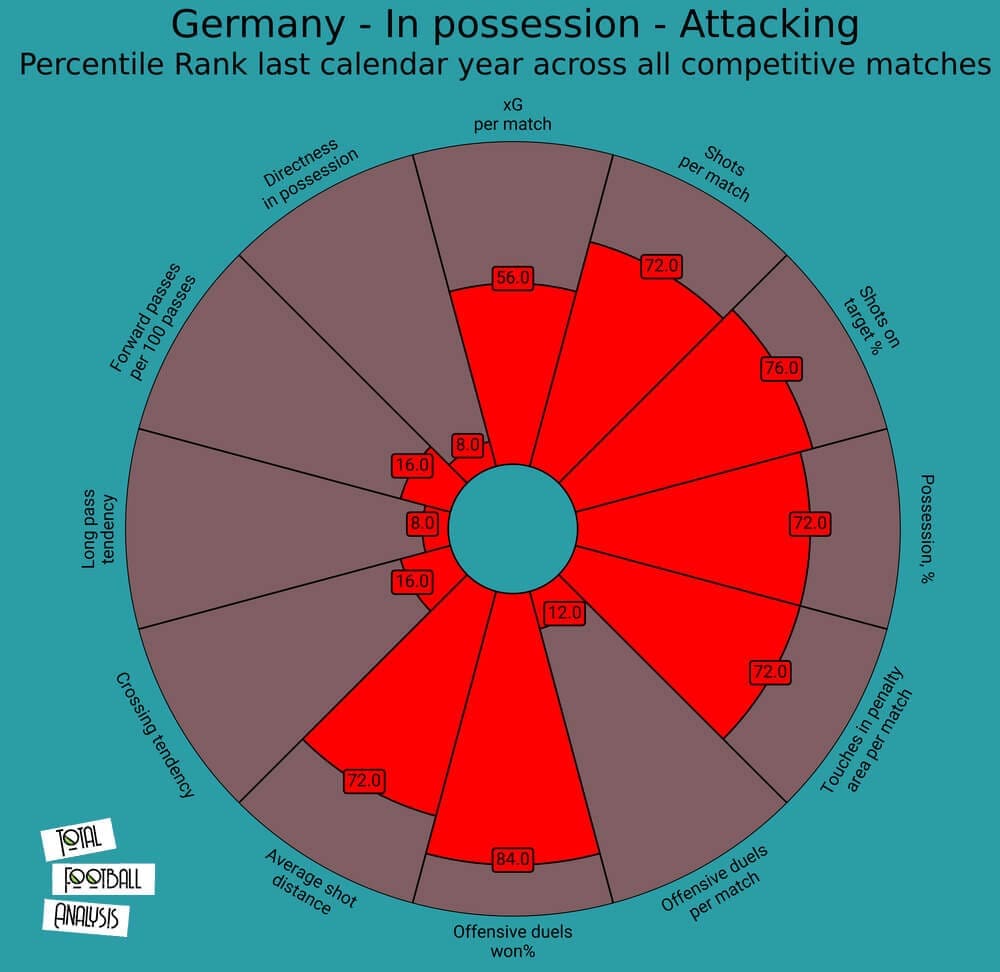
Germany’s build-up structure relies on their central midfielders often to create overloads, and the interaction between the full-back, inside forward and central midfielder are key. We can see a deeper example here against Romania, where Germany work the ball through the full-back. Germany play into the centre backs, and so Kai Havertz, who played as an inside forward in this game drops into the half-space to receive. With Havertz dropping, Goretzka then makes a run higher, and Goretzka can be found by Klostermann in the central area. With Havertz and Goretzka both occupying the half-space, an overload is created, and when Romania react to this, a diagonal ball is played into the far central midfielder Gündoğan, who is completely free. Germany have interchanged roles quite well between full-backs and wingers, with Lukas Klostermann performing well and often bombing forward into the half-space if it became vacated against Romania.
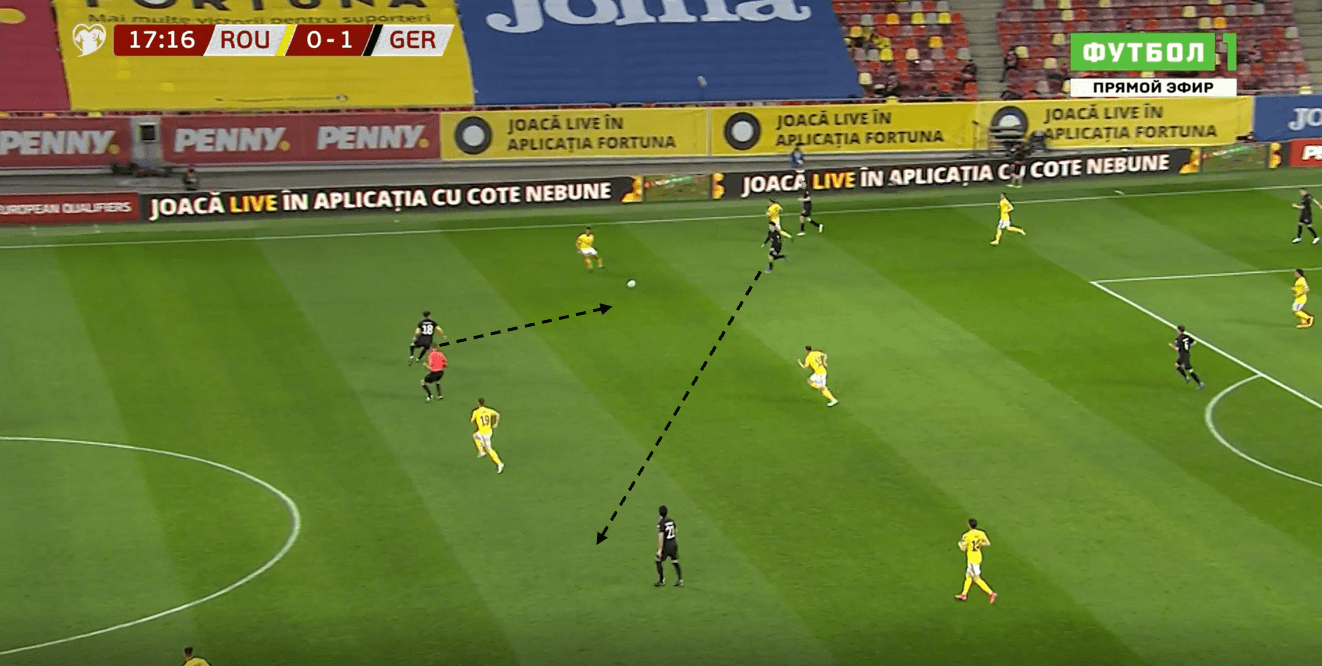
To create such overloads, or to open passing lanes, Germany will occasionally form a back three, with one full-back moving narrower to act as a centre back, allowing the whole backline to stretch, which in turn stretches the opposition’s first line. Doing this allows for a full-back to space much wider and higher, and so the inside forward and nearest central midfielder can occupy the inside lanes and receive the ball.
In qualifiers against weaker opposition they will often be structured in this almost 3-1-6 structure, with Goretzka often particularly offensive when he plays. Here Sané occupies the full-back, while Can pushes on to provide width and to also overload this full-back. Gündoğan’s role is vital to the attack, as it allows an overload to be created on a centre back, with him and Gnabry able to create this. Without this overload, it can be difficult to progress the ball cleanly, and so with Germany using a 4-1-4-1 in possession in qualifiers, it allows the nearest central midfielder to create that overload consistently.
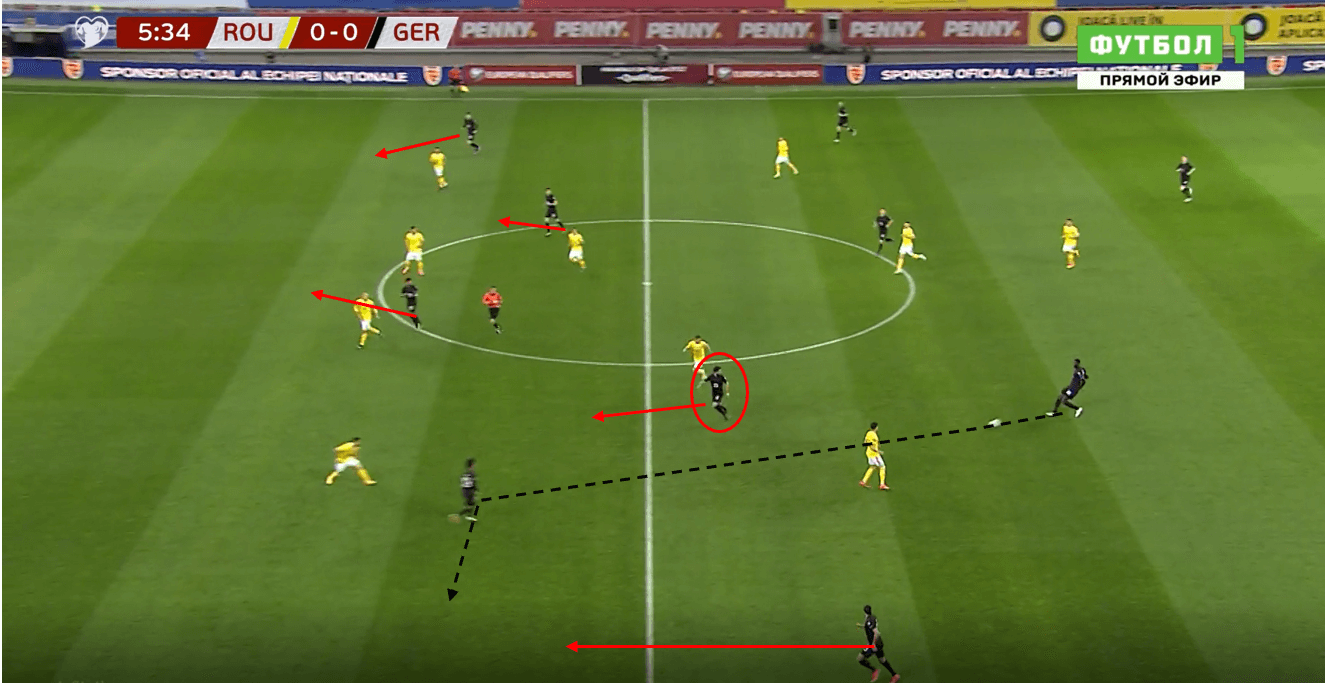
As will be discussed in the transition section though, Germany may have to tone this structure down slightly, and I would expect more of a 4-2-3-1 shape to evolve in possession. As a result, there would be more responsibility on that ‘number ten’ within the system (likely Gündoğan), and so he would have to shift to support the ball often and time his movement to receive the ball well. An overload cannot always be created, and it isn’t always needed, however it is an extremely useful and efficient method in progressing the ball. Serge Gnabry has also dropped deeper to create overloads at times, and if Thomas Müller starts up front, I would expect him to look to create central overloads to allow ball progression
Something Germany should look to take advantage of is the threat they pose in behind, as well as the threat they pose in terms of ball progression through midfield. The combination of these things makes teams consider whether to press high or drop off slightly, and if they can beat presses with combinations such as this, and then play in behind, they could find success.
DEFENSIVE PHASE
Germany operate a 4-1-4-1 mid-high block out of possession, and this area of the game is probably their biggest weakness, with their system being exploited by the likes of North Macedonia and Switzerland, as well as being completely annihilated by Spain. Against lesser opposition they are happy to press higher, however they still do not press too intensely as a result of their system as I will explain. They concede a slightly concerning number of shots per match, and this is more concerning when you consider the amount of possession they usually have, and the relative lack of action the defence sees, as evidenced by their defensive and aerial duels per 90.
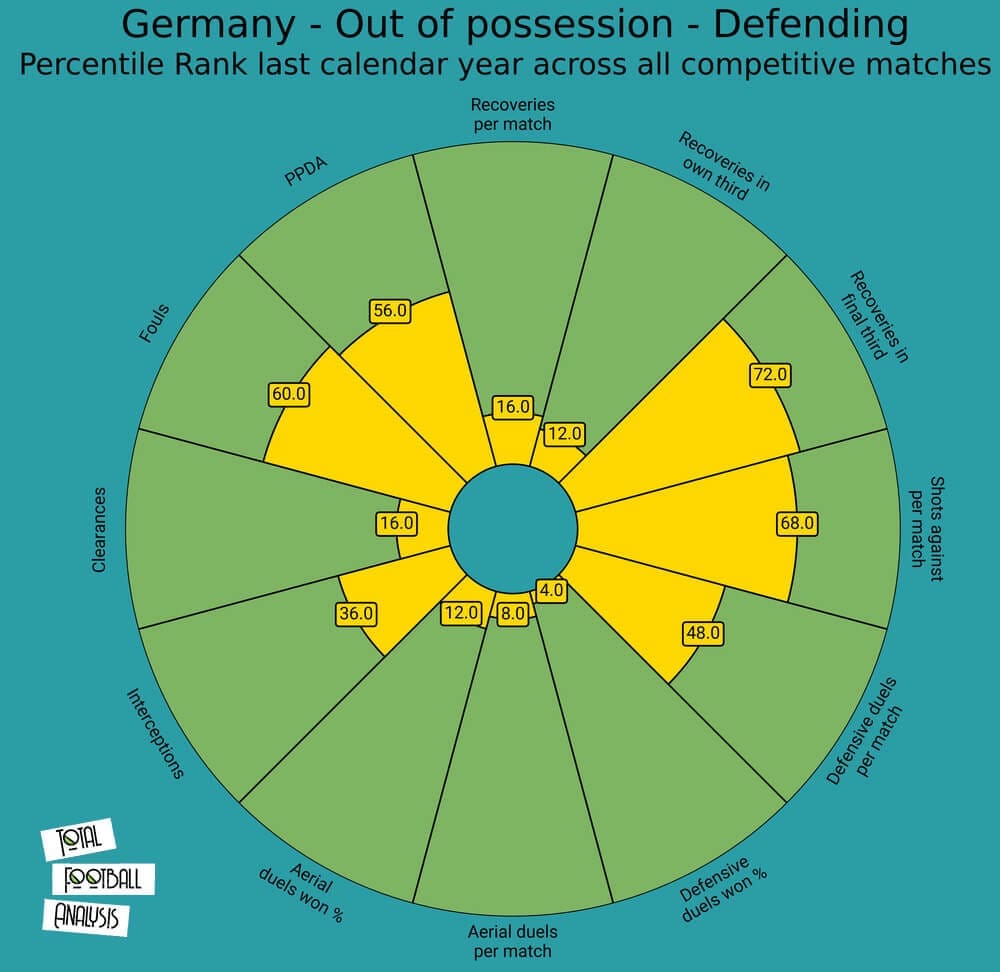
Their 4-1-4-1 structure sees their wingers press against full-backs from inside to out, and so they protect the inside lane initially, while central midfielders press outwards with opposition central midfielders in a fairly relaxed fashion often, with neither clear player or clear zonal orientation. Players instead seem more option based, but this executed badly often leading to some poor mistakes. We can see an example here of this basic 4-1-4-1 structure, with Goretzka here pressing out with the nearest central midfielder. However he allows him to turn here and play the ball forwards, which immediately gives Romania access to Germany’s last line.
Germany’s last line can therefore often be dragged higher, and the centre backs can be quite aggressive, which opens the opportunity for the opposition to play in behind.
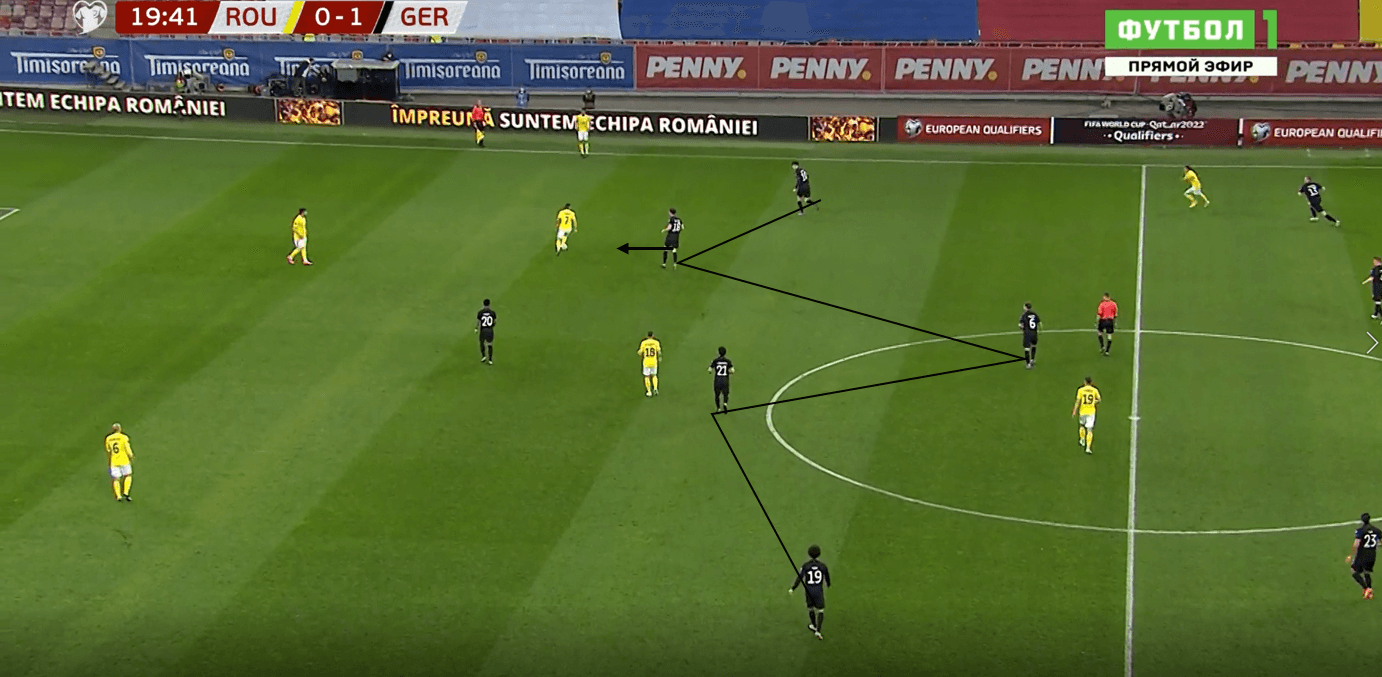
Germany’s system tends to be forced into being more passive due to the lack of pressure on the centre backs. The central striker is tasked with pressing the two centre backs, but this is often done poorly, with passing lanes between centre backs rarely cut, and pressing triggers badly executed. Because of this lack of pressure on the ball, it often forces one of Germany’s central midfielders to push into the first line to press. This can create an overload for the opposition in the second line, however with compactness and good timing of the pressing run it can be managed. Germany don’t really do either of those things consistently well, and so they are often caught with central midfielders higher, but poor pressure on the ball, all of which leads to the opposition progressing.
Here for example Germany have pressed higher with the nearest central midfielder initially, and so fall into more of a 4-4-2 before the ball is forced wide. After pressing a centre back and forcing the ball wide, Gündoğan drops back to cover Spain’s nearest pivot. This means there is no pressure on the centre back on the ball. As Gündoğan goes to cover this near pivot, we can see far central midfielder Toni Kroos also jumps to press the same player, and he therefore leaves a large central space behind him. This leaves Goretzka alone to defend a central area, and with no pressure from the front, Spain can play a simple pass into the player behind Goretzka and progress.
Mid blocks without pressure on the centre back can work, but without compactness and coverage of space, teams with any quality should simply pick you apart, as Spain did here. If Kroos sits off and remains close to Goretzka, Gündoğan can cover both the near pivot and Kroos’ player, and Spain would have no space to play forward into. Germany need to press two centre backs more efficiently using cover shadows and arced pressing runs against better opposition, as if they don’t teams will just trigger their central midfielders to press for fun and gradually pick them off.
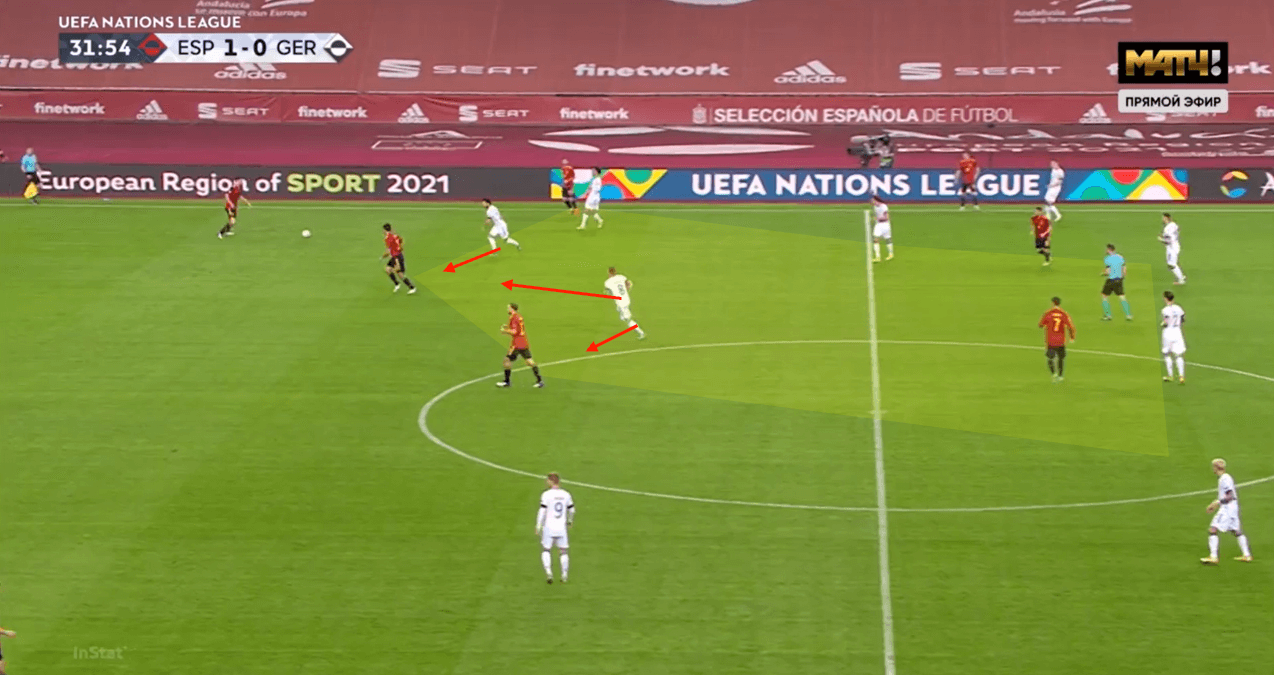
TRANSITIONS
As stated earlier, Germany’s in possession shape will likely have to adjust against the better sides in order to maintain a good counter-pressing structure. In a counter-pressing example here, we see both Goretzka and Gündoğan have gone forward into their usual structure, while six Joshua Kimmich has also been dragged forward after attempting a long shot. As a result, when they lose possession, Germany have only their full-backs and centre backs available to press from in front of the ball (goal side), and so better sides would punish them massively here. Even if they attack with two central midfielders along the backline, that leaves only the number six available to counter-press directly from the front, and so this one player cannot cover space effectively and can be easily bypassed. Against the likes of Portugal and France they will need two players behind the ball shielding the backline if they are to regularly prevent counter-attacks.
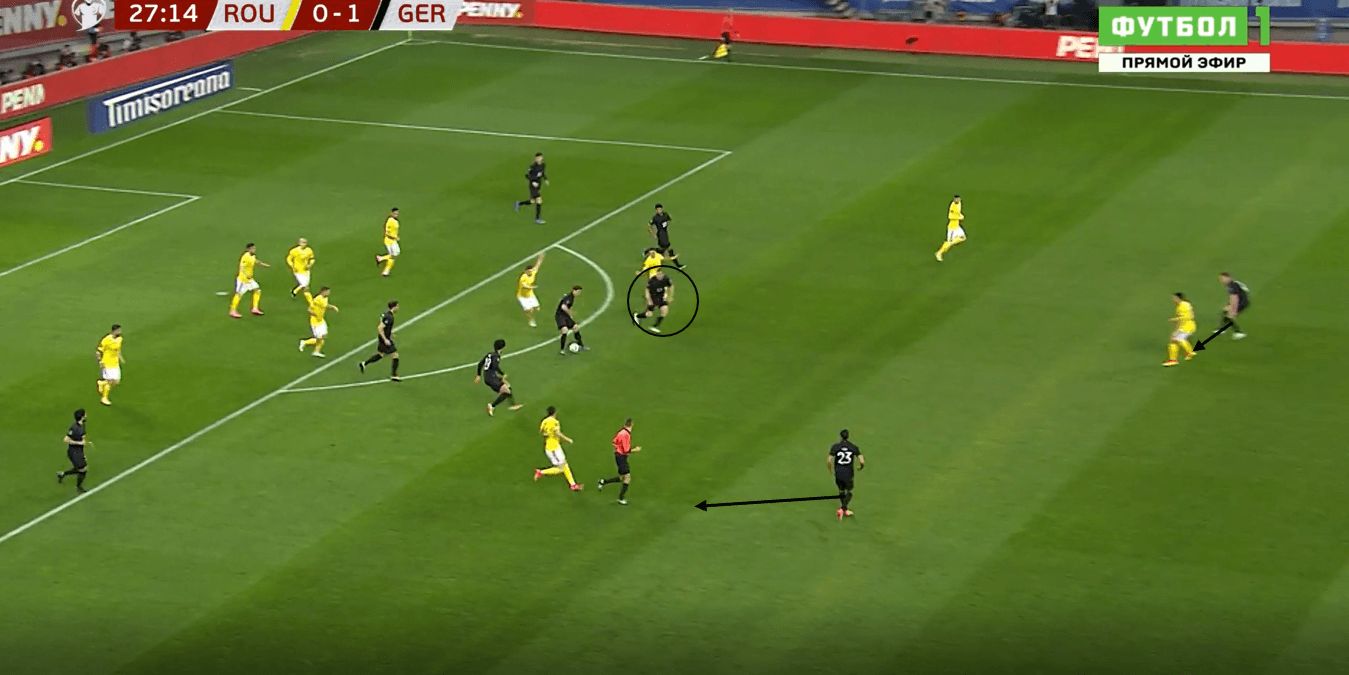
In terms of offensive transition, Germany often rely on the verticality of the likes of Werner and Gnabry, as well as the high-speed dribbling of Leroy Sané. The wingers will tuck narrower in transition, and their pace allows them to support play quickly. The ball can often be recovered by the German central midfielders when they become more passing lane oriented, and so when this happens the likes of Goretzka and Kimmich are good at escaping any initial counter-press and releasing the ball into an onrushing attacker. It will be interesting to see how much Germany rely on offensive transitions throughout the tournament.
FORWARDS
If we look at pure forwards for Germany in the last year, we see Germany are struggling for a real predator in the box, with no players really standing out as taking a high number of shots or contributing goals or assists. Timo Werner has had a notoriously tough season for Chelsea, and so we can see his goal contributions are nothing to shout about, while Gnabry leads the way for the forwards shown. His numbers are solid, but again don’t really stand out in the data, with ten goals and five assists in the Bundesliga this season.
Due to this lack of an obvious goalscorer, I expect Germany will look to spread the goals and rely more on interchanges and movement to create chances for their forwards, rather than relying on a consistent focal point.
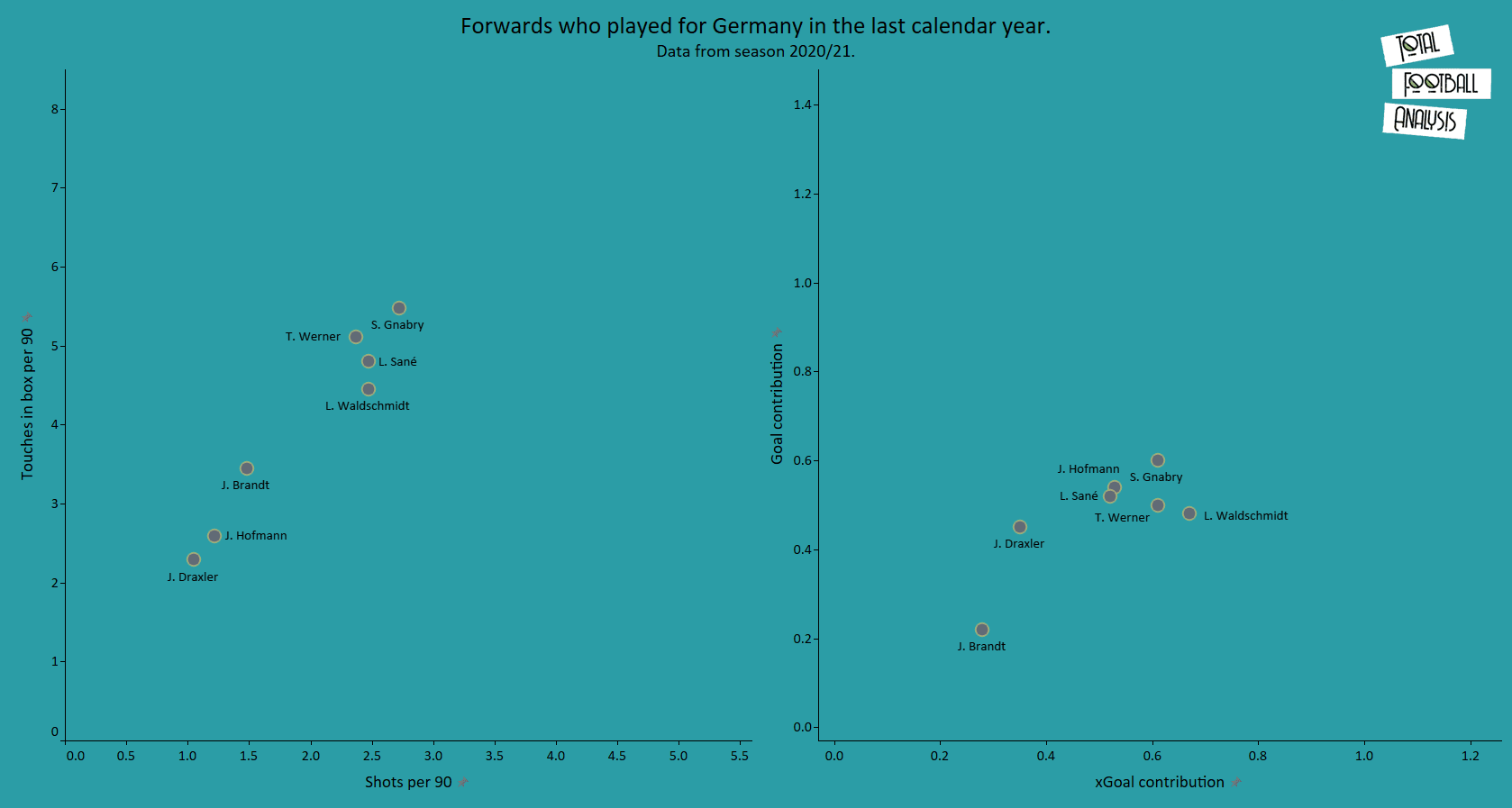
MIDFIELDERS
In midfield, we see a much more obvious data spread. When looking at progressive passing, we see Toni Kroos and Joshua Kimmich lead the way, with their accuracy also excellent. This is to be expected from the pair, who both play key ball progression roles for their clubs. Florian Neuhaus, who perhaps misses out on the squad just due to his playing style being similar to others, has also put up some impressive numbers in a struggling Gladbach side this season. Gündoğan and particularly Havertz are very low in terms of ball progression metrics, however, Germany do not rely too much on either of these players for progressive passing. For example, Kai Havertz has played as an inside forward mostly for Chelsea and positioned himself in the right half-space, and so he usually receives passes into the final third rather than playing them.
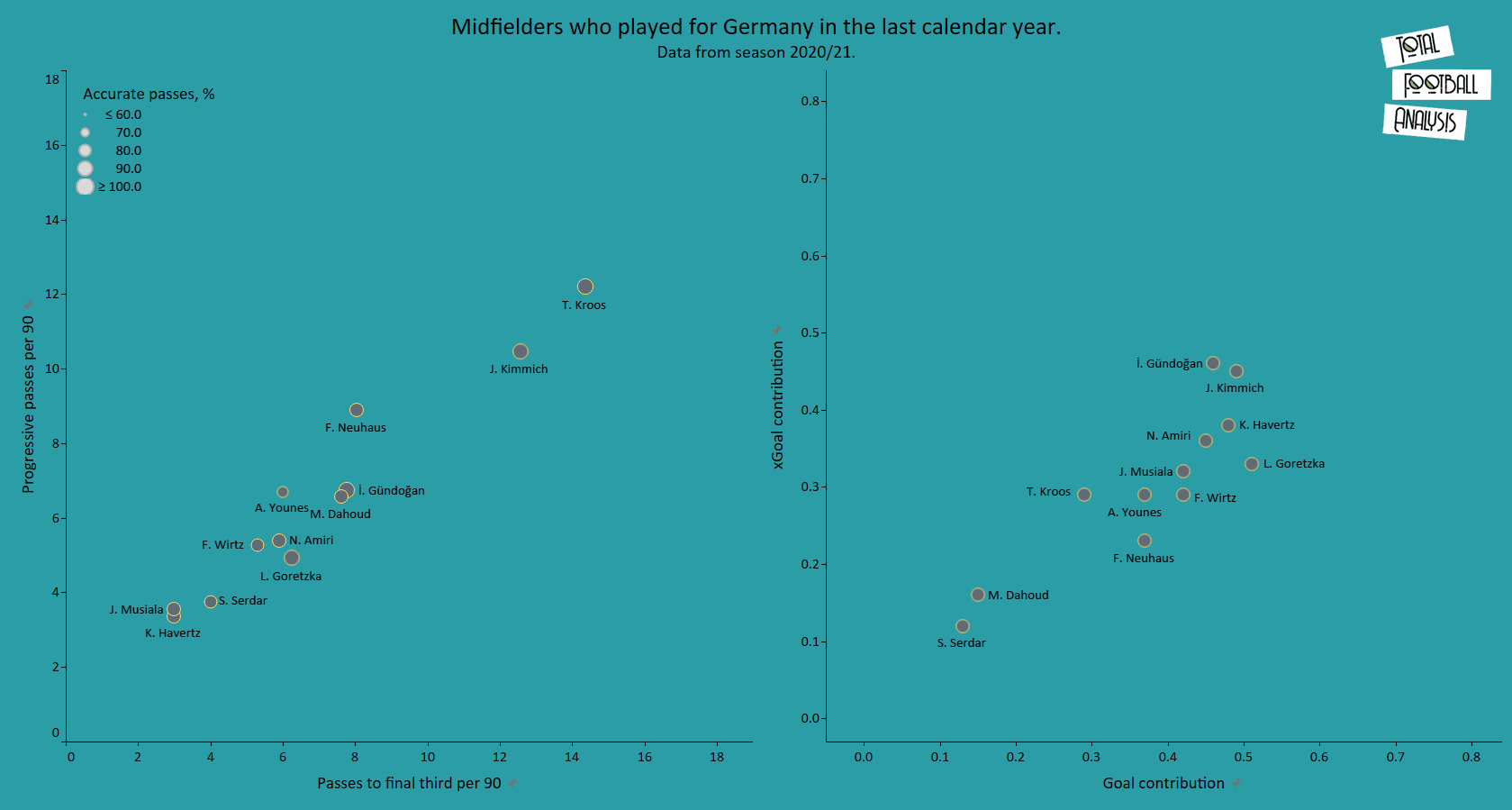
DEFENDERS
In the defending department, we see a very even data set again, with Germany’s starting players not really showing themselves in the data. Robin Koch has the most successful defensive actions and interceptions, however he has played in a Leeds United team all year whose man-oriented system actively creates many duels and defensive actions. Nico Schulz and Phillip Max, both previously capped left-backs, are seen at the bottom of the graph and have struggled in both of these areas, which likely contributed to neither player getting the call up.
In terms of ball progression from defenders, we see Niklas Süle performing well for progressive runs and decently for progressive passing, as is Emre Can who plays midfield also. Matthias Ginter has been impressive with his progressive passing, and this is something that will be relied upon for his role as a full-back at the tournament. Marcel Halstenberg missed out on the squad, however his numbers are good in progressive passes and runs. He has not played as regularly for RB Leipzig as in previous seasons though.
One shock from the data is that Robin Gosens does not stand out in terms of progressions, with the Atalanta wing-back offering far more of an offensive threat than you would expect from looking at this data. For all of Robin Koch’s defensive actions, he seems to be struggling to progress the ball well, and this will be something Leeds and the national team will look to work on with him.
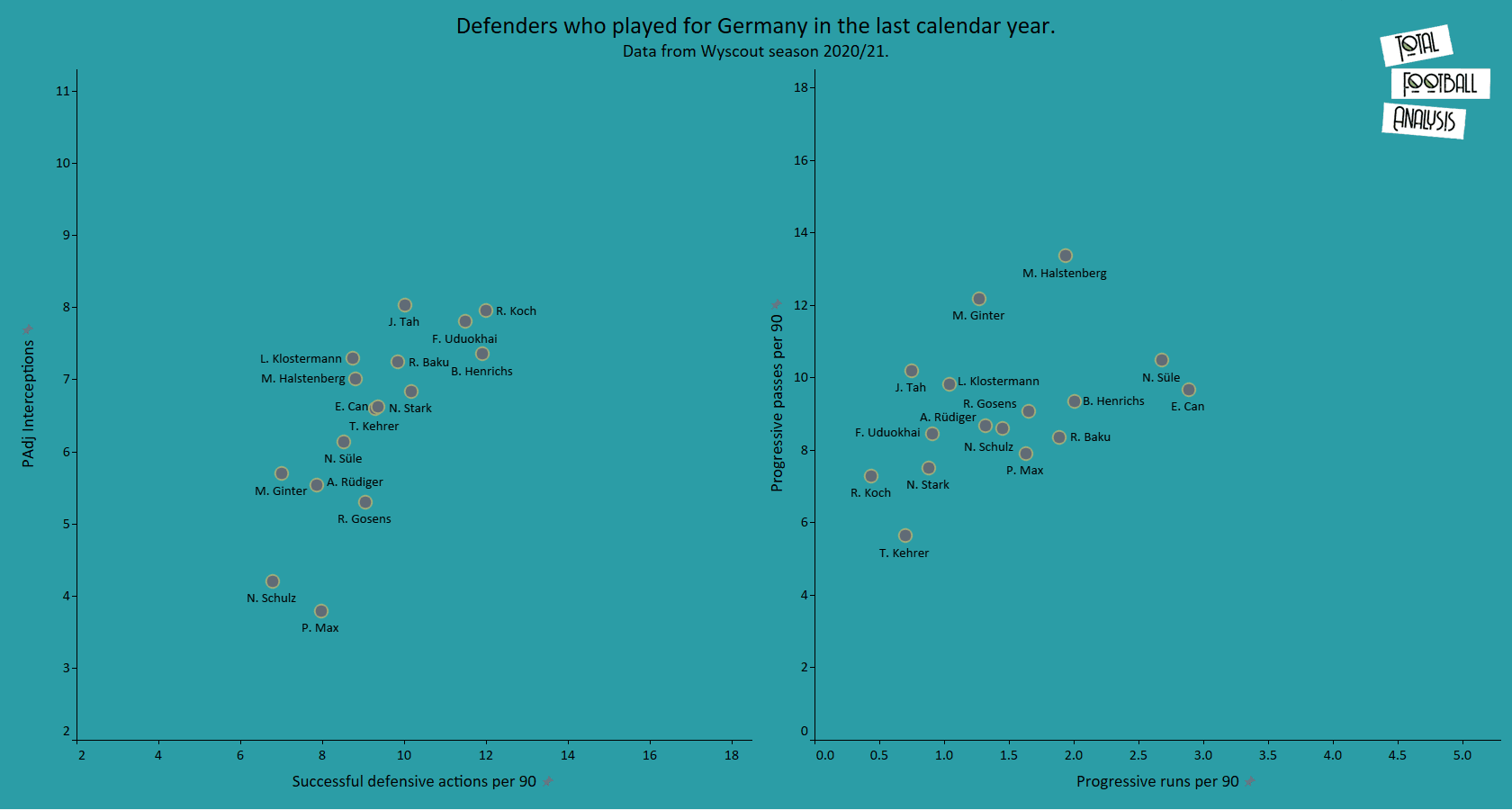
BEST PERFORMERS
I have highlighted Toni Kroos as Germany’s best performer in the squad, with the 31-year-old still able to dictate games at will and progress the ball against even the toughest defence. If we look at his passing and progression data we can see this is clearly his biggest strength, with his metrics in passes to the final third, number of passes, and the actual accuracy of those passes being very high. His forward pass ratio is not too high, however to perform the role of a pivot successfully, not all passes have to be forward passes, and sometimes playing sideways or backwards creates a better angle or position for ball progression and retention. His passing range allows him to access threats in behind, such as Vinícius Júnior at club level, or potentially Leroy Sané and Timo Werner at this coming tournament.
In terms of attacking and creativity, we see again he plays a high number of different pass types. He averages only 0.89 touches in the penalty area per 90, however this is to be expected with his role being more in deeper build-up. When the ball is in a higher area, he aims to maintain an effective rest defence to allow Madrid to counter-press or restrict the opposition effectively if they lose possession. Kroos averages 0.2 expected assists per 90 and 1.46 shots on target, of which a large majority are long shots.
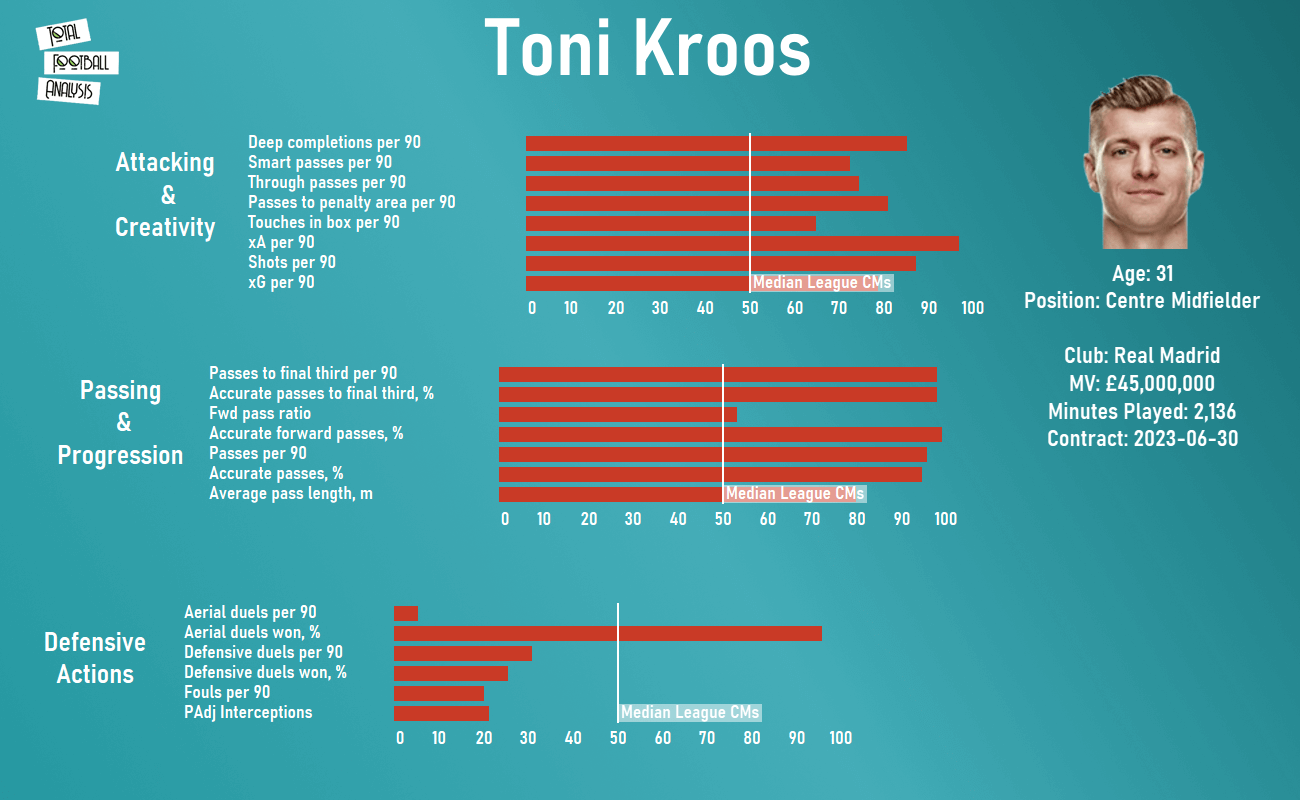
Defensively, we see his metrics are low for all stats per 90. Real Madrid have averaged 59% possession in the last calendar year though, and with most of his work being in the rest defence phase, it is to be expected that his defensive metrics are low. His lack of pace and athleticism make him not much of an intense presser, and so this also contributes to his low defensive metrics. Casemiro can help Kroos in this regard at a club level, and if Germany are to press high I expect they will rely on the more athletic central midfielders in the squad to do the bulk of the sprints, with Kroos likely to excel in more of a passing lane oriented role. Teams may look to take advantage of this though, and forcing Kroos to engage in the press could create some rewards for the opposition.
PREDICTIONS FOR THE TOURNAMENT
Germany have been drawn into Group F, which can easily be considered the ‘group of death’ for the tournament, with Hungary, France and Portugal making up the rest of the group. France and Portugal have extremely strong squads and are fancied as some of the favourites for the tournament, and so Germany face an uphill task to qualify from the group stage, especially when this group is combined with all of the chaos occurring around the German national team at the moment. Their game against Portugal will be a crucial one, as although Portugal have a very strong squad and are the reigning champions of the tournament, they did not have the strongest World Cup qualifiers, and their defence could be troubled by the Germans.
Germany could also qualify for the knockout stages as one of the best third-placed teams, with four slots available for this, however they would have to put in convincing displays against France and Portugal and would likely have to beat Hungary by a good margin. Hungary are no pushovers either and have talent within their squad, and they could pose Germany problems from set-pieces.
If they get to the knockout round, I wouldn’t expect to see them make it past the quarter-finals, however with knockout football anyone can beat anyone. For me, as shown in this scout report, there are too many question marks around their out of possession play, and with them not likely to be allowed all of the ball as they are so used to in qualifiers, I think they could struggle massively against the quality sides.

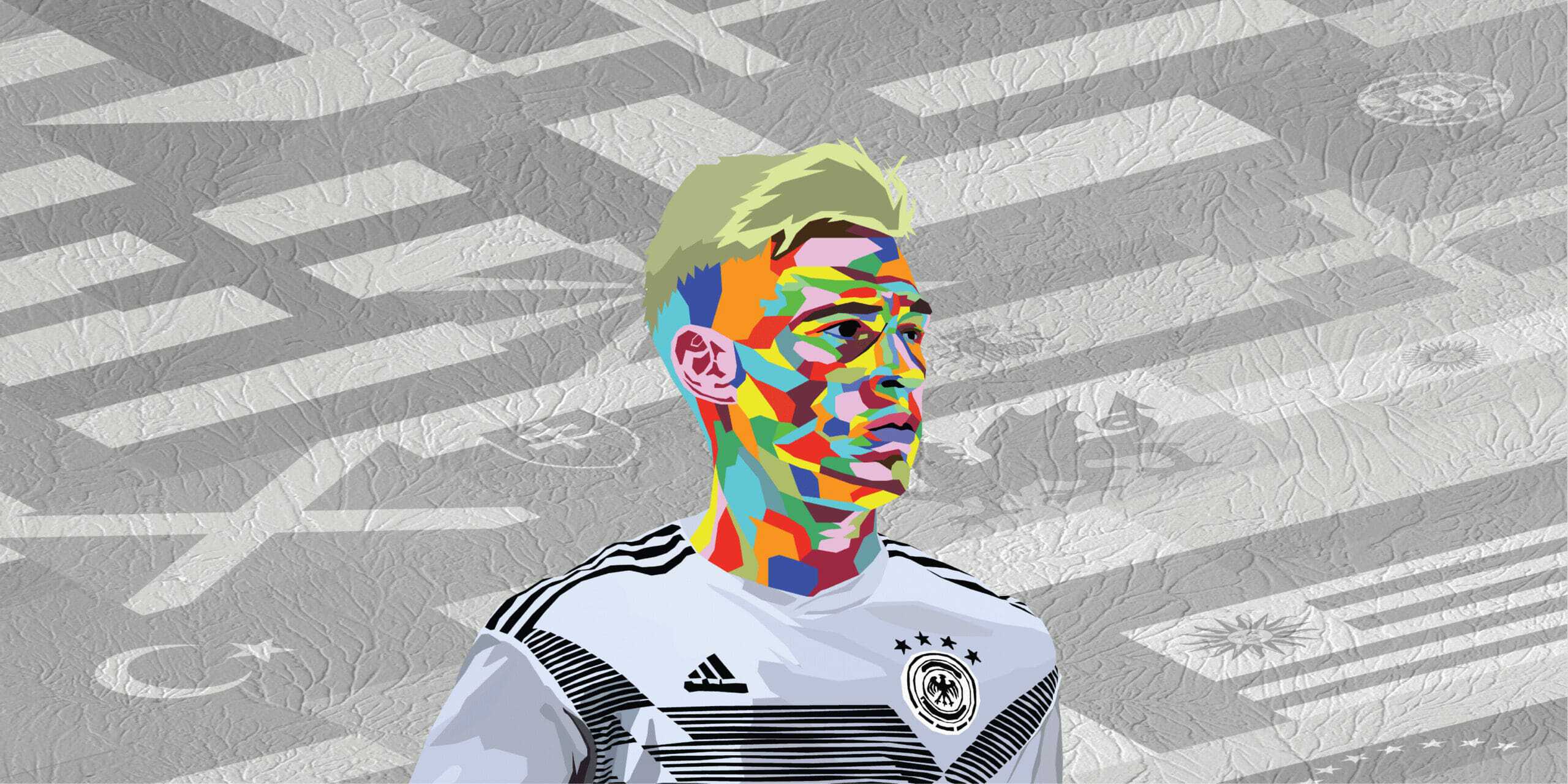



Comments